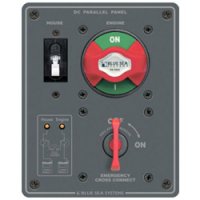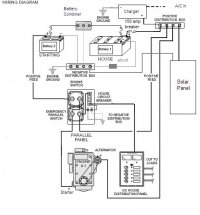Tom Metzger
Sustaining Partner
Loren - The shunt MUST be inserted into the 1/0 black wire between the house bank and the engine ground point (at least it's 1/0 on the E-34, E-32, and E-35-3). If the house and start batteries use the same negative wire going to the engine ground point then the shunt has to be placed so only the house bank current goes through it. In other words, you may have to rewire the negative connections on the two banks to accomplish this.
The attached sketch, which was drawn for a different purpose, shows where the shunt has to be wired in for either battery if they have a common negative connection to the engine. Most likely, it would be easiest to eliminate the jumper between the batteries and run a separate wire from the disconnected battery to the engine.
The engine power (starter, glow plugs, pump, blower, and instruments) does not go through the #4 wire to the distribution panel. It comes off the battery switch.
I hope this helps.
The attached sketch, which was drawn for a different purpose, shows where the shunt has to be wired in for either battery if they have a common negative connection to the engine. Most likely, it would be easiest to eliminate the jumper between the batteries and run a separate wire from the disconnected battery to the engine.
The engine power (starter, glow plugs, pump, blower, and instruments) does not go through the #4 wire to the distribution panel. It comes off the battery switch.
I hope this helps.
Attachments
Last edited:



